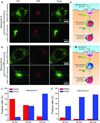Tunable, ultrasensitive pH-responsive nanoparticles targeting specific endocytic organelles in living cells
- PMID: 21495146
- PMCID: PMC3438661
- DOI: 10.1002/anie.201100884
Tunable, ultrasensitive pH-responsive nanoparticles targeting specific endocytic organelles in living cells
Figures





References
-
- Singhal S, Nie S, Wang MD. Annu. Rev. Med. 2010;61:359–373. - PMC - PubMed
- Riehemann K, Schneider SW, Luger TA, Godin B, Ferrari M, Fuchs H. Angew. Chem. Int. Ed. 2009;48:872–897. - PMC - PubMed
- Weissleder R, Pittet MJ. Nature. 2008;452:580–589. - PMC - PubMed
- Davis ME, Chen Z, Shin DM. Nat. Rev. Drug Discov. 2008;7:771–782. - PubMed
- Peer D, Karp JM, Hong S, Farokhzad OC, Margalit R, Langer R. Nat. Nanotech. 2007;2:751–760. - PubMed
-
- Wang C, Chen Q, Wang Z, Zhang X. Angew. Chem. Int. Ed. 2010;49:8612–8615. - PubMed
- Olson ES, Jiang T, Aguilera TA, Nguyen QT, Ellies LG, Scadeng M, Tsien RY. Proc. Natl. Acad. Sci. USA. 2010;107:4311–4316. - PMC - PubMed
- Bernardos A, Aznar E, Marcos MD, Martínez-Máñez R, Sancenón F, Soto J, Barat JM, Amorós P. Angew. Chem. Int. Ed. 2009;48:5884–5887. - PubMed
Publication types
MeSH terms
Substances
Grants and funding
LinkOut - more resources
Full Text Sources
Other Literature Sources

